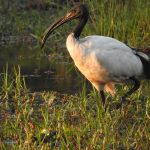In this post I have decided to include mountain birds of Extremadura, but also rock birds, which don’t necessarily have to be associated with mountain ranges.
Alpine accentor Prunella collaris

Present mainly on the slopes of Gredos, it breeds in bushes and is one of the mountain birds of Extremadura that inhabits higher altitude areas. It is quite confident, so it will let us get quite close. It feeds on invertebrates and differs from the common accentor by its characteristic white collar, especially present with its recently molted plumage. We can also find it in Villuercas, Tiros mountain range and the central mountain ranges of Badajoz in winter.
Alpine swift Apus melba

The largest of the swifts, it is characterized by its white belly which makes it unmistakable in the distance. It usually nests near water, in bridge hollows, cracks and rocky river and reservoir cuts. In winter it migrates to Africa. On the wall of the Alange lake is the largest breeding colony in Extremadura. We can also see interesting nuclei in the Sierra de Pela, the city of Badajoz, the Sierra de las Villuercas or Monfragüe.
Black wheatear Oenanthe Leucura

The third and last species of wheatear present in the peninsula and the region. Typical of arid areas, with rocky escarpments or walls, its diet is also insectivorous. Slightly larger than its relatives, its black color makes it unmistakable. It is present all year round in the region and we can observe it practically all over the community. The sierras of San Pedro, Hornachos and the central sierras of Extremadura, for example, are good places to see them.
Blue rock thrush Monticola solitarius

This bird, the size of a thrush, stands out because of its blue colours. A typical inhabitant of mountainous areas, it likes to frequent the rocks, ruins, walls, castles and other buildings located at a certain altitude. It feeds on small invertebrates and even hunts small lizards. The mountains of Tiros, Pela, central mountains of Badajoz, Villuercas, cut off from the Alcántara lake, Monfragüe and La Vera are areas where it’s commonplace.
Bluethroat Luscinia svecica

Unmistakable by the blue colour of its throat, this beautiful bird breeds only in Gredos, above 1800 m. Select alpine environments where there is a mosaic of bushes, woods and meadows. In Extremadura we have 2 populations, the wintering one that comes from the North of Europe and the sedentary one. It is a rather scarce species, however, in addition to Gredos, we can observe it in Vegas Altas del Guadiana or Almaraz in winter. It mainly feeds on insects although it supplements its diet with seeds and some vegetables.
Common raven Corvus corax

It is the largest corvid present in the region and the peninsula. Like all of them, it stands out for its great capacity to adapt, both in terms of habitat and feeding. It is more abundant in the areas where there are rock cuts where it nests, however it adapts to any ecosystem. It can also breed in large trees or electric construction towers. Its diet is omnivorous, it feeds on everything it finds: small animals, eggs, placentas, grain, fruit… It is distributed throughout the community, as long as it finds suitable areas to nest nearby.
Common whitethroat Sylvia communis
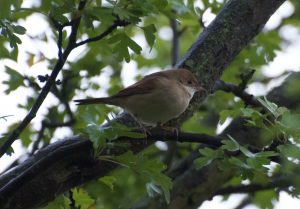
Very small bird whose male is characterized by a blue-grey “hood”. Both the male and the female have white throats. Very typical of the mountain bushes, it breeds only in the mountains of northern Cáceres. After breeding, it is distributed throughout the region and ends up migrating to Africa in winter. It likes areas with a mosaic of copses, bushes, hedges and meadows in which it feeds on small insects.
Crag martin Ptyonoprogne rupestris

Browner in colour than the house martin, it nests in rocky cliffs and is the only species in its category that does not migrate to Africa in winter. I include it among the mountain birds of Extremadura because of its predilection for rocky ecosystems. Its habitat will logically be linked to these structures and the best places to observe them are Tiros mountain range, the area of Puerto Peña, Monfragüe, La Vera and the Jerte valley. It is also abundant in the area of Los Llanos de Cáceres, where it usually makes its nests in the bridges.
Dunnock Prunella modularis

Similar in size to the Alpine accentor, its distribution is much wider, occupying lower altitudes than this in the Extremadura mountains. Frequent in areas of bush and undergrowth on the slopes of these mountains, most Extremaduran populations are only wintering. There are two interesting breeding nuclei in the northern part of the province of Cáceres and in Villuercas, and it can be found throughout the territory during the winter months.
Eurasian dotterel Charadrius morinellus

Short-billed wader with a distinctive white eyebrow. Unlike other birds, the female has a much more showy nuptial plumage than the male. It normally inhabits northern Europe and Asia, but in Spain there is a small breeding nucleus in the Pyrenees. During the migratory season it can be found all over the peninsula, including Extremadura, mainly in mountainous areas. It is quite scarce and there is no stable population in the region.
European pied flycatcher Ficedula hypoleuca
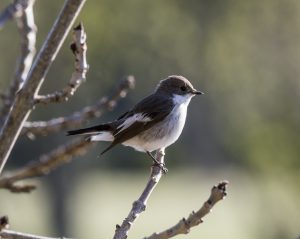
Small bird with a very fine beak whose male is characteristic for his black and white colours. Breeds in the forest areas of the mountain massifs, above 1000 metres. In Extremadura it only breeds in Gredos, although it is then distributed throughout the region. It feeds on small insects that lurk in trees or bushes that serve as its watchtower. Its population is in small decline due to various factors including a fragmented habitat and forest management that does not favour it.
Jackdaw Corvus monedula

Corvidian, the size of a dove, very social, used to move in large groups on a daily basis. Very opportunistic, it takes advantage of any kind of food it can find: insects, small reptiles, rodents, fruits… It usually nests in churches, farmhouses and old buildings with holes. In spite of having included it among the mountain birds of Extremadura, its enormous capacity of adaptation allows it to be present in almost all the region, being especially abundant in the mountain range of Tiros, the central mountain ranges of Badajoz, the mountain range of Pela and the zone of the dam of Badajoz.
Northern wheatear Oenanthe oenanthe

Unlike the blonde wheatear, the grey and black wheatear are included among the mountain birds. In Extremadura we only find them in the north of the province of Cáceres, being much more common in Castilla y León. It is adapted to all kind of environments and it is especially comfortable with the altitude, that’s why we can find it in Gata, Hurdes or Gredos. The male is characteristically grey on the back and top of the head, while the wings and a stripe on the face are black. The female is browner with a dark stripe on the face.
Ortolan bunting Emberiza hortulana

It is the only species of bunting that migrates in winter to warmer lands. Although it can live in a wide variety of habitats, the mid-mountain is where it is most comfortable, so it is in mountain birds of Extremadura section. In Extremadura we can see it mainly in the northern half of the province of Cáceres. It feeds mainly on invertebrates, although it does not shy away from seeds when it has the opportunity. It is characterized by having a yellow throat, eye ring and whisker.
Red-billed chough Phyrrocorax phyrrocorax

Corvid species only present in areas of rocks, cliffs and steep mountain ranges. Slightly larger a jackdaw, it is characterized by its red beak and legs. Unlike other corvids, its diet is mainly based on invertebrates. In Extremadura it is rather scarce, but we can find it in Monfragüe, Villuercas, Pela and Tiros mountain ranges and also in La Campiña Sur.
Ring ouzel Turdus torquatus

Very occasional in Extremadura, it can be seen sporadically in both Cáceres and Badajoz. In the Iberian Peninsula there are only stable populations all year round in northern mountain areas, but in autumn and winter we can see some birds from central and northern Europe in Extremadura. At this time of year it likes mid-mountain areas with pine trees, junipers or scrubland. It feeds mainly on small fruits and despite being a rare species, it is not endangered.
Rock dove Columba livia
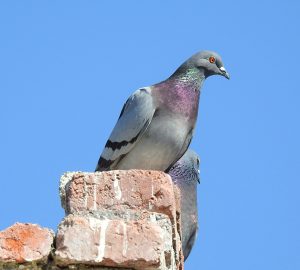
There is little to add about this bird, so typical of our urban centres. Most of its population lives in urban areas, moving to nearby crop fields to feed. However, I include it here, as there are certain populations that live totally “wild” in cliff areas. Mountain ranges and river canyons are often their favourite breeding and resting places. Their ecological role is very important, as they are common prey for several protected birds of prey: Bonelli’s eagles, peregrine falcons, goshawks… Common throughout the region.
Rock sparrow Petronia petronia

This species of sparrow is characterised by the fact that there is hardly any sexual dimorphism between males and females. It can be seen in a wide variety of habitats, although it has a preference for rocky areas and cliffs. However, it can also be seen in open forest environments, steppe, crops, villages or abandoned buildings. It is not as dependent on humans as other sparrows. More abundant in the province of Cáceres than in the province of Badajoz, it is not a species with conservation problems at present. It is a robust sparrow with a strong beak and is easily distinguished by its peculiar song.
Rock thrush Monticola saxatilis

One of the 2 species of rock thrush present in Extremadura, whose colours are unmistakable, especially in adult males. Very scarce both in the peninsula and in Extremadura, its ideal habitat is high mountain scrub (always above 1000m) with few trees. It is a summer bird in the peninsula, and feeds on insects. The area of the Central System, Villuercas and Monfragüe are the best places to observe it.
Sand martin Riparia riparia

It is the smallest of the martins and usually nests in large colonies on sandy river slopes. Duller in colour than the common house martin, it is easily identified by the band on its chest. It also feeds on insects that it captures exclusively in flight and migrates to Africa in winter. Its presence is dispersed in the region and its population suffers great fluctuations. However, during the migratory season it can be seen in flocks of hundreds of passing birds from European countries.
Water pipit Anthus spinoletta

Common throughout the Iberian Peninsula, this bird can be seen in Extremadura mainly during the winter. It breeds in mountainous areas but in winter it can descend in altitude, being observed in lower pastures or even wetland edges. The water or alpine pipit stands out for its long tail, its white stripes on the back and its dark brown legs. It feeds mainly on invertebrates that it also captures on the banks of rivers and streams.
White – rumped swift Apus caffer
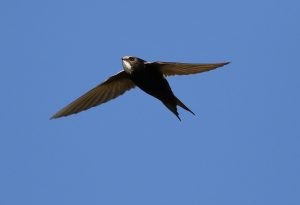
A summer visitor to Extremadura, its population is really small. Of sub-Saharan origin, its appearance in the region is rather recent. Small and black in colour, it is characterised by its forked tail. It has a small white spot on its throat and a small white spot on its throat. Like its congeners, it feeds mainly on flying insects. It usually nests on rocky outcrops, cliffs, bridges… and often steals the nests of the red-rumped swallow. It can be seen in both Cáceres and Badajoz, being very scarce in both provinces.
Thanks to Angel Cañones, Mariano Cordero and Álvaro de las Heras for the pictures.





